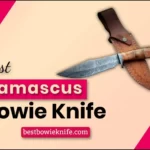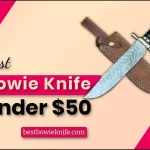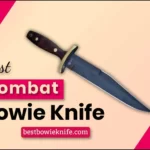Are you want to know what is Bowie knife? Here you will get all relative information about the best Bowie knife.
Inventor of the Bowie Knife
At the beginning of the 19th century, Rezin Bowie created a pattern of fixed-blade fighting knives for his brother Jim Bowie. He was most famous for his utilizing large knives in sandbar fights.
There is very limited information available about James Bowie. There is a serious possibility that Bowie fought only one personal knife fight. National publicity followed the Sandbar Fight. He wore a large knife prominently after the Sandbar fight.
In addition to its name and reputation, the Bowie knife is named after James Bowie, a legendary knife fighter who died at the Battle of the Alamo.
History of the Bowie Knife
It is difficult to trace the history of the Bowie knife in its early form because of murky definitions, and conflicting claims. There is no clear definition of the Bowie knife.
In the mid-20th century, there were most knives having some combination of blade length and shape. It is not possible to clearly define the knife’s origins without a generally accepted definition. It was applicable to a wide variety of blades in the mid-19th century.
A complicating factor is that some American knives meeting the modern definition of a Bowie knife precede the Bowie knife.
While the term has come to refer to any large sheath knife with a crossguard and clip point. It has become recognizable and characteristic over the years because of its distinctive design features.
The Bowie knife pattern continues to be popular among collectors. There are hundreds of custom knife makers that produce Bowie knives in different steels and variations along with various knife manufacturing companies.
During this period, the Bowie knife was already available in a variety of sizes with a blade length similar to that of a carving knife.
The Original Purpose of Invention
The main purpose for developing a bowie knife was combat and a short sword. It was shorter than a saber but retained a heavy blade. It had sufficient weight for a slashing attack. But you can also use it for cutting and thrust sword fighting.
Properties of Early Bowie Knife
A Bowie knife from the early days does not fit the popular image of the weapon. There is a concave arch cut into the end of the blade, and a cross-guard for the protection of the hand.
Early examples of the knife had a thick, heavy blade with a straight back and no hand guard or clip point. There was a variation in the length of the blade from 81/2-121/2 inches, and their edge was very sharp. Silver pins and washers were used to connect the wooden handles.
During the 1830s, Searles’ knives were decorated with silver nails and were made from one piece of ebony. Blacksmiths added A rudimentary cross-guard to most later Bowie knives to prevent hand slippage.
They lengthened the guards, In order to protect themselves from an opponent’s blade. The clip point was very popular and it was a curve on the top of the blade just behind the point.
The clips were also sharp so that a backstroke could cause serious injury. The spear-point blades in the Bowie knives were in dagger shape. They were forged and sharpened on both sides.
Bowies made by blacksmiths are usually plain and unsigned. They have iron or brass mountings and are crafted from hardwood, bone, or horn. As well as being a hunting knife, this knife serves as a tool also.
You can use it to clear a path, hack a tree, dig a hole, or butcher a game with it. The Texans used the Bowie knives during the siege of Bexar in 1835 to dig through walls and roofs and fight hand-to-hand with Mexican troops.
In the early days of these knives, the intention of people was just to fight. But now they use them for many common purposes like combat, throwing, self-defense, hunting, etc.
What Makes A Great Bowie Knife?
If you’re not familiar with Bowie knives and don’t know what you’re looking for, don’t worry. You should review the following features and decide which one perfectly fits your needs and intended use.
1. Handle
There is a great deal of variety here. For a little extra money, you can get a Bowie with a staghorn handle. There are some bone-made handles as well.
Standard wood handles do not cost as much as others. So if you are trying to save money, we recommend that you purchase this one.
However! it is important to remember that these handles have two halves. These halves are connected by a joint and as such are more susceptible to warping and damage.
There are several modern options available, including composite handles and glass fiber-infused handles. Although they are typically cheaper, they differ from what David Bowie used in the past.
2. Steel
Remember that sharpness is essential for bowie knives. If you are using knives outside the city then you should use high-carbon or stainless steel. Ideally, you should select a steel that has superior edge retention and can handle aggressive cutting without chipping.
It is sufficient to remember that cheap Bowie knives typically have cheaper steel. It may take some trial and error to find the right balance between price and functionality.
3. Size
You can find Bowie knives in a variety of sizes, from 5 inches to 24 inches. Just remember that larger sizes are heavier and bulkier. It is critical to balance this against how you intend to use the Bowie.
In order to clear a small amount of shrubbery at a campsite, you do not need the large Bowie knife. A larger knife is necessary if you want to cut down small trees.
It is our suggestion that any Bowie knife with a blade length of fewer than 6 inches is impractical and loses some of its functionality.
Conclusion
If you’ve got a clear sense of what you’re looking for, then you’re on the right track. We hope you were able to list some of the features that are of particular importance to you and your intended use.
Take what you have learned from this “What is a Bowie knife?” guide and apply it to your daily life. This article provides you with all the information you need to make the right decision and secure a Bowie knife that you will keep around for a long time. Good luck with your chopping!

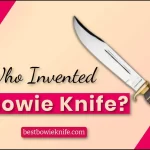
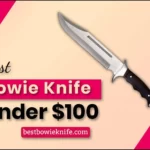
![Best Bowie Knife Reviews 2024 | Guide for Everyone [Top 20 Products] Best Bowie Knife Reviews 2024 | Guide for Everyone [Top 20 Products]](https://m.media-amazon.com/images/I/31hfV62McQL._AC_.jpg)
